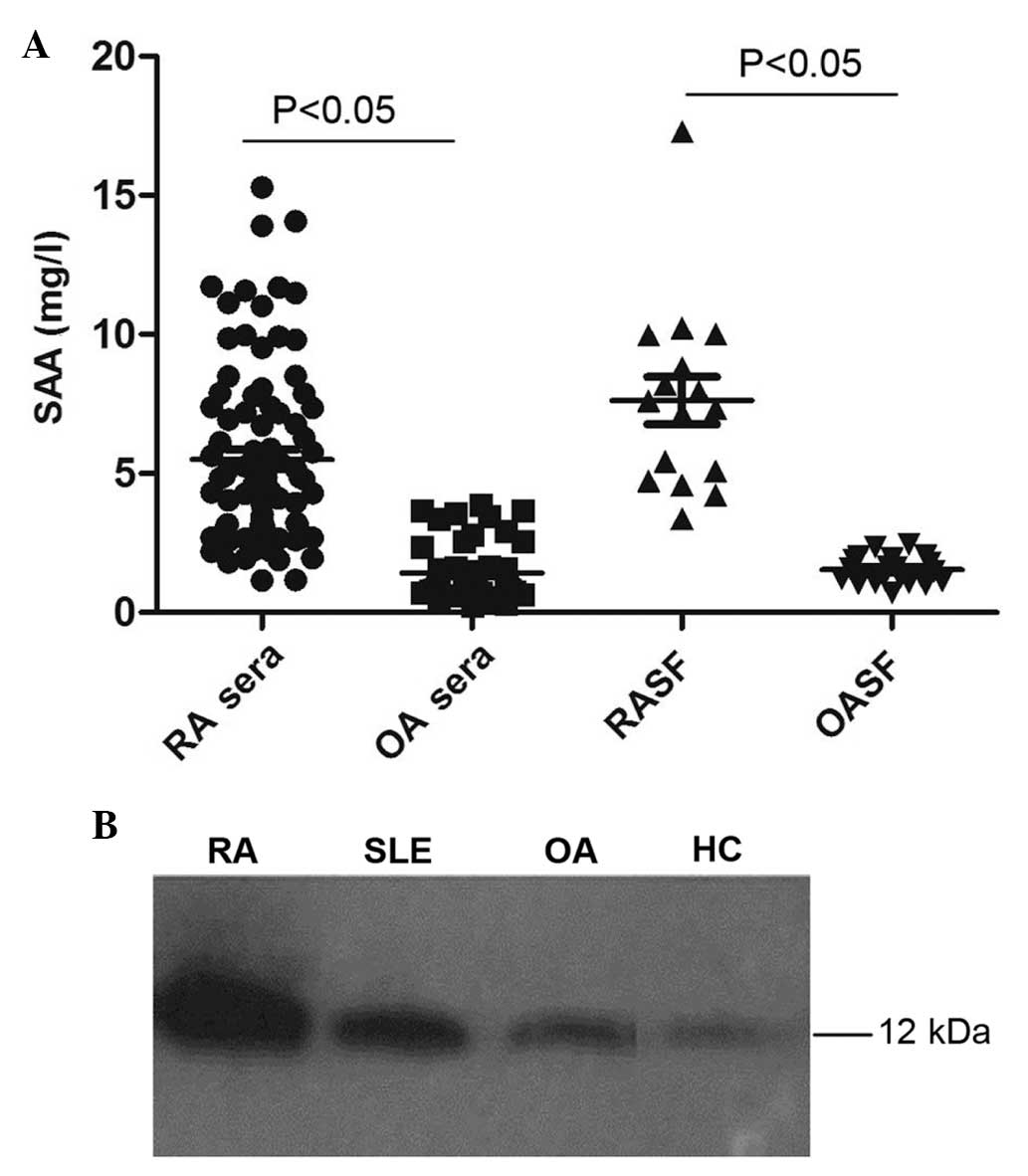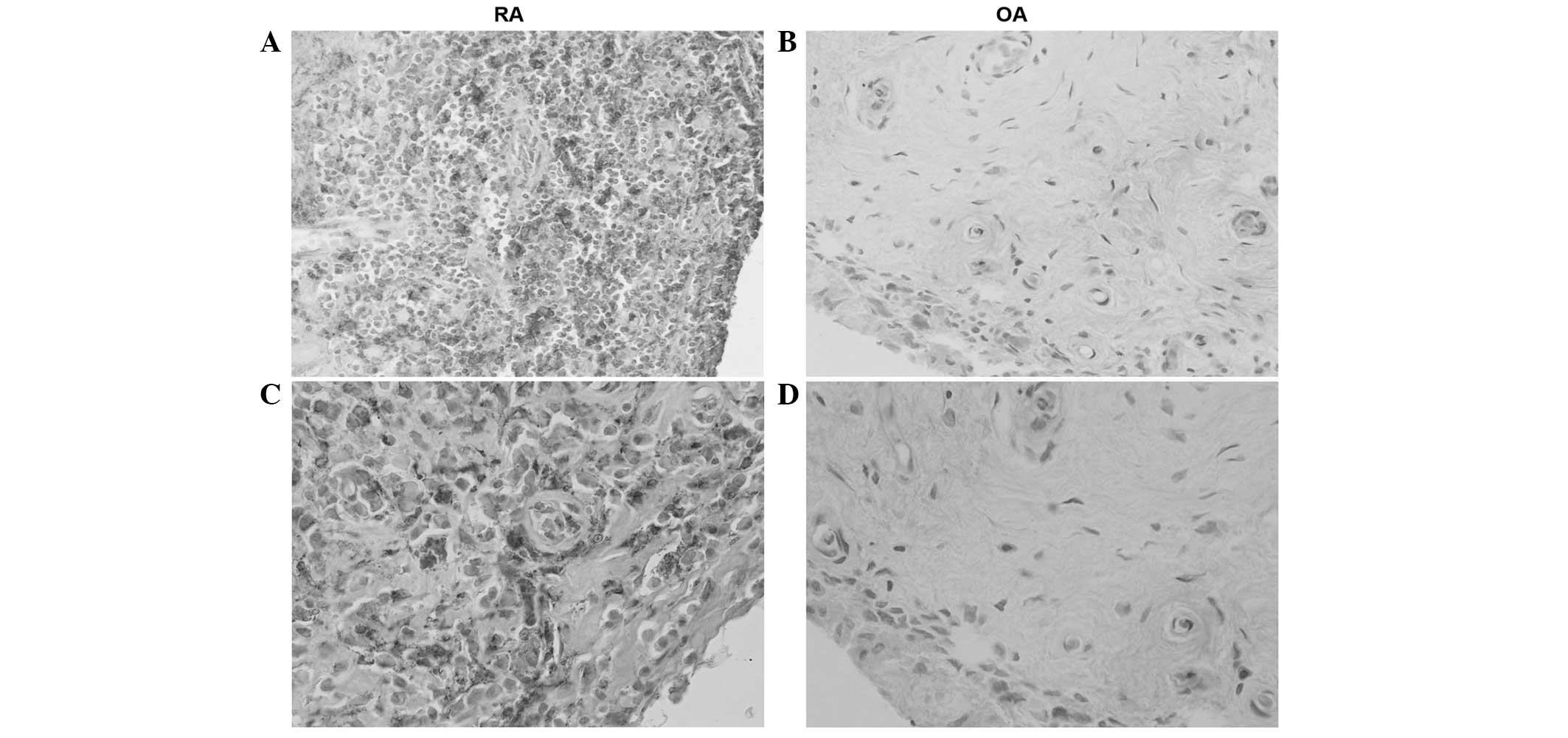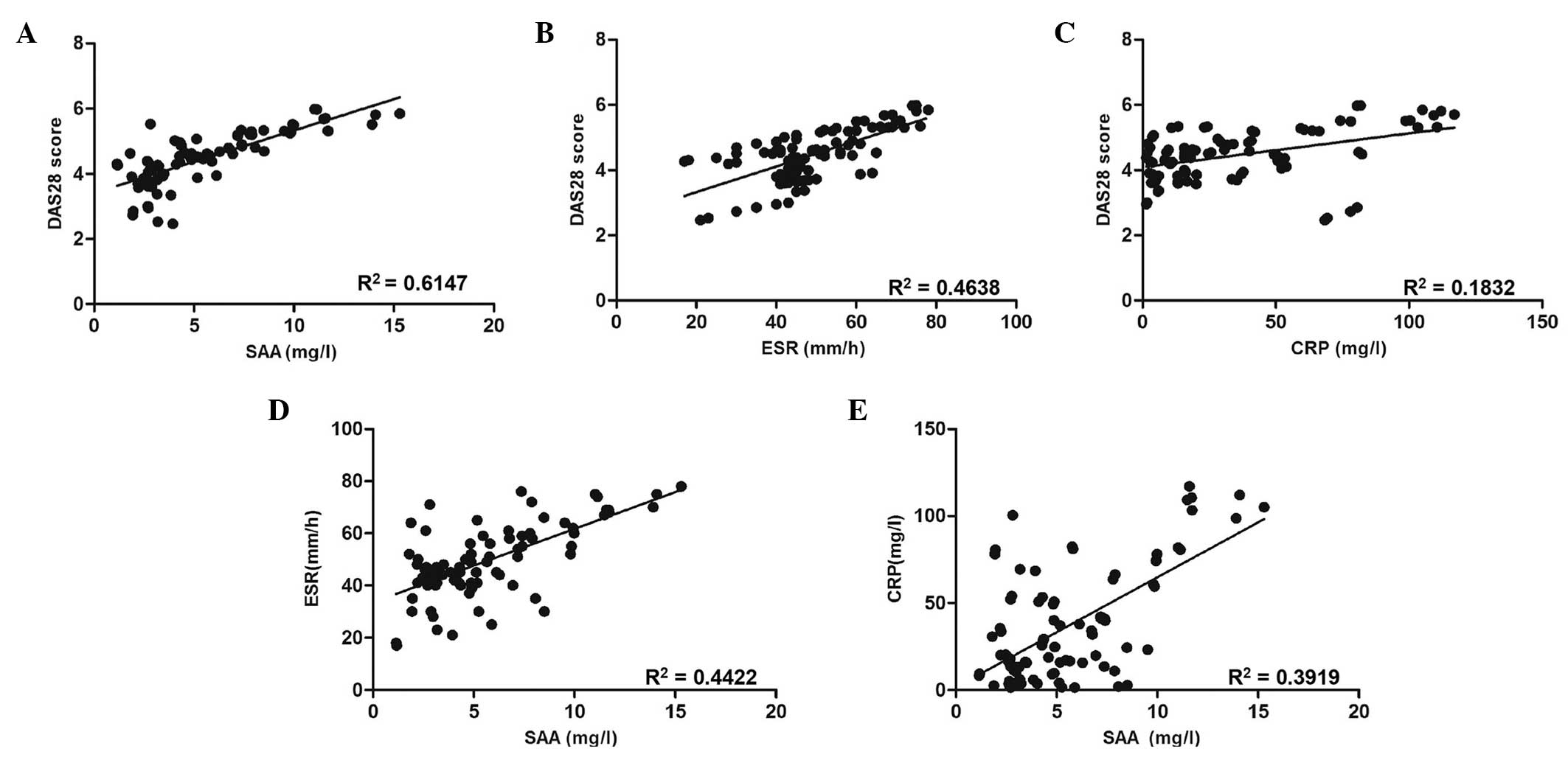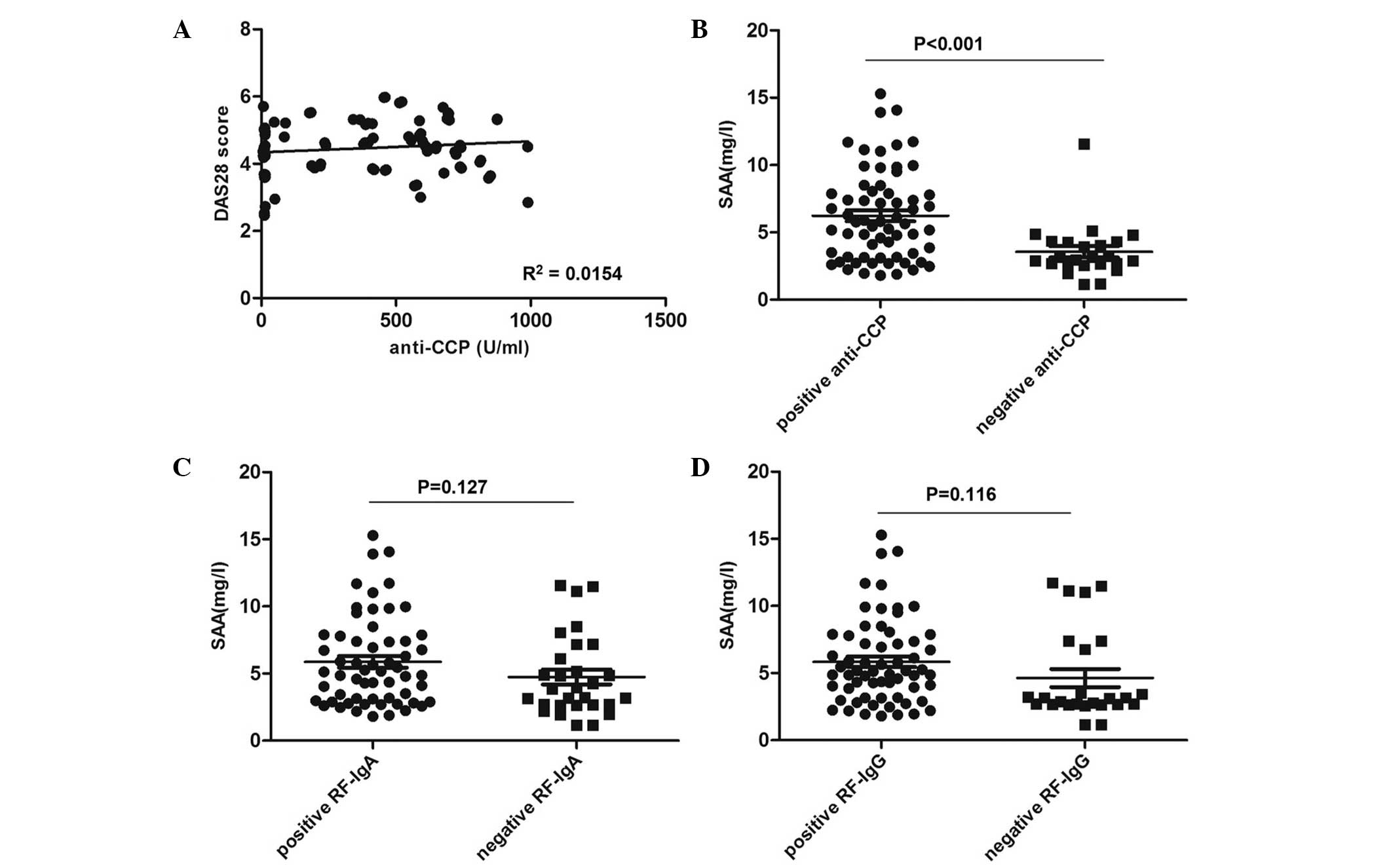|
1
|
Scott DL, Wolfe F and Huizinga TW:
Rheumatoid arthritis. Lancet. 376:1094–1108. 2010. View Article : Google Scholar : PubMed/NCBI
|
|
2
|
McInnes IB and Schett G: The pathogenesis
of rheumatoid arthritis. N Engl J Med. 365:2205–2219. 2011.
View Article : Google Scholar : PubMed/NCBI
|
|
3
|
Emery P: Evidence supporting the benefit
of early intervention in rheumatoid arthritis. J Rheumatol. 66:3–8.
2002.
|
|
4
|
Fransen J and van Riel PL: The disease
activity score and the EULAR response criteria. Clin Exp Rheumatol.
23(5 Suppl 39): S93–S99. 2005.PubMed/NCBI
|
|
5
|
Aletaha D, Landewe R, Karonitsch T, et al:
EULAR, ACR: Reporting disease activity in clinical trials of
patients with rheumatoid arthritis: EULAR/ACR collaborative
recommendations. Arthritis Rheum. 59:1371–1377. 2008. View Article : Google Scholar : PubMed/NCBI
|
|
6
|
Matsui T, Kuga Y, Kaneko A, et al: Disease
Activity Score 28 (DAS28) using C-reactive protein underestimates
disease activity and overestimates EULAR response criteria compared
with DAS28 using erythrocyte sedimentation rate in a large
observational cohort of rheumatoid arthritis patients in Japan. Ann
Rheum Dis. 66:1221–1226. 2007. View Article : Google Scholar : PubMed/NCBI
|
|
7
|
Da Mota LM, dos Santos Neto LL, Burlingame
R, et al: Laboratory characteristics of a cohort of patients with
early rheumatoid arthritis. Rev Bras Rheumatol. 50:375–388.
2010.
|
|
8
|
Aletaha D, Neogi T, Silman AJ, et al: 2010
Rheumatoid arthritis classification criteria: an American College
of Rheumatology/European League Against Rheumatism collaborative
initiative. Arthritis Rheum. 62:2569–2581. 2010. View Article : Google Scholar : PubMed/NCBI
|
|
9
|
Papadopoulos NG, Tsiaousis GZ,
Pavlitou-Tsiontsi A, Giannakou A and Galanopoulou VK: Does the
presence of anti-CCP autoantibodies and their serum levels
influence the severity and activity in rheumatoid arthritis
patients? Clin Rev Allergy Immunol. 34:11–15. 2008. View Article : Google Scholar : PubMed/NCBI
|
|
10
|
Mullan RH, Bresnihan B, Golden-Mason L, et
al: Acute-phase serum amyloid A stimulation of angiogenesis,
leukocyte recruitment, and matrix degradation in rheumatoid
arthritis through an NF-κB-dependent signal transduction pathway.
Arthritis Rheum. 54:105–114. 2006. View Article : Google Scholar
|
|
11
|
Dong Z, Wu T, Qin W, et al: Serum amyloid
A directly accelerates the progression of atherosclerosis in
apolipoprotein E-deficient mice. Mol Med. 17:1357–1364. 2011.
View Article : Google Scholar : PubMed/NCBI
|
|
12
|
Eklund KK, Niemi K and Kovanen PT: Immune
functions of serum amyloid A. Crit Rev Immunol. 32:335–348. 2012.
View Article : Google Scholar : PubMed/NCBI
|
|
13
|
Jung SY, Park MC, Park YB and Lee SK:
Serum amyloid a as a useful indicator of disease activity in
patients with ankylosing spondylitis. Yonsei Med J. 48:218–224.
2007. View Article : Google Scholar : PubMed/NCBI
|
|
14
|
Cantarini L, Giani T, Fioravanti A, et al:
Serum amyloid A circulating levels and disease activity in patients
with juvenile idiopathic arthritis. Yonsei Med J. 53:1045–1048.
2012. View Article : Google Scholar : PubMed/NCBI
|
|
15
|
Shimojima Y, Matsuda M, Gono T, Ishii W
and Ikeda S: Serum amyloid A as a potent therapeutic marker in a
refractory patient with polymyalgia rheumatica. Intern Med.
44:1009–1012. 2005. View Article : Google Scholar : PubMed/NCBI
|
|
16
|
Ferrari R, Tanni SE, Caram LM, Corrêa C,
Corrêa CR, et al: Three-year follow-up of interleukin 6 and
C-reactive protein in chronic obstructive pulmonary disease. Respir
Res. 20:14–24. 2013.
|
|
17
|
O’Hara R, Murphy EP, Whitehead AS,
FitzGerald O and Bresnihan B: Acute-phase serum amyloid A
production by rheumatoid arthritis synovial tissue. Arthritis Res.
2:142–144. 2000. View
Article : Google Scholar
|
|
18
|
Momohara S, Okamoto H and Yamanaka H:
Chondrocyte of rheumatoid arthritis serve as a source of
intra-articular acute-phase serum amyloid A protein. Clin Chim
Acta. 398:155–156. 2008. View Article : Google Scholar : PubMed/NCBI
|
|
19
|
Vallon R, Freuler F, Desta-Tsedu N, et al:
Serum amyloid A (apoSAA) expression is up-regulated in rheumatoid
arthritis and induces transcription of matrix metalloproteinases. J
Immunol. 66:2801–2807. 2001. View Article : Google Scholar
|
|
20
|
de Seny D, Cobraiville G, Charlier E, et
al: Acute-phase serum amyloid a in osteoarthritis: regulatory
mechanism and proinflammatory properties. PloS One. 8:e667692013.
View Article : Google Scholar : PubMed/NCBI
|
|
21
|
Metawi SA, Abbas D, Kamal MM and Ibrahim
MK: Serum and synovial fluid levels of interleukin-17 in
correlation with disease activity in patients with RA. Clin
Rheumatol. 30:1201–1207. 2011. View Article : Google Scholar : PubMed/NCBI
|
|
22
|
Migita K, Koga T, Torigoshi T, et al:
Serum amyloid A protein stimulates CCL20 production in rheumatoid
synoviocytes. Rheumatology (Oxford). 48:741–747. 2009. View Article : Google Scholar
|
|
23
|
Mullan RH, Bresnihan B, Golden-Mason L, et
al: Acute-phase serum amyloid A stimulation of angiogenesis,
leukocyte recruitment, and matrix degradation in rheumatoid
arthritis through an NF-κB-dependent signal transduction pathway.
Arthritis Rheum. 54:105–114. 2006. View Article : Google Scholar
|
|
24
|
Okamoto H, Katagiri Y, Kiire A, Momohara S
and Kamatani N: Serum amyloid A activates nuclear factor-kappa B in
rheumatoid synovial fibroblasts through binding to receptor of
advanced glycation end-products. J Rheumatol. 35:752–756.
2008.PubMed/NCBI
|
|
25
|
Farheen K and Agarwal SK: Assessment of
disease activity and treatment outcomes in rheumatoid arthritis. J
Manag Care Pharm. 17(9 Suppl B): S09–S13. 2011.PubMed/NCBI
|
|
26
|
Connolly M, Mullan RH, McCormick J, et al:
Acute-phase serum amyloid A regulates tumor necrosis factor α and
matrix turnover and predicts disease progression in patients with
inflammatory arthritis before and after biologic therapy. Arthritis
Rheum. 64:1035–1045. 2012. View Article : Google Scholar
|
|
27
|
Thorn CF, Lu ZY and Whitehead AS:
Regulation of the human acute phase serum amyloid A genes by tumour
necrosis factor-alpha, interleukin-6 and glucocorticoids in hepatic
and epithelial cell lines. Scand J Immunol. 59:152–158. 2004.
View Article : Google Scholar : PubMed/NCBI
|
|
28
|
Agrawal S, Misra R and Aggarwal A:
Autoantibodies in rheumatoid arthritis: association with severity
of disease in established RA. Clin Rheumatol. 26:201–204. 2007.
View Article : Google Scholar
|













